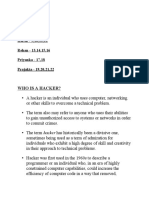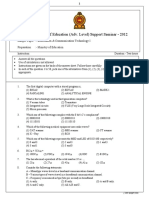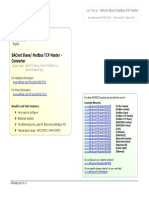Advanced Networking Interview Questions and Answers
Networking Fundamentals
1. Q: What is the OSI model? A: A conceptual framework with 7 layers: Physical, Data Link,
Network, Transport, Session, Presentation, Application.
2. Q: Explain the differences between TCP and UDP. A: TCP is connection-oriented and reliable;
UDP is connectionless and faster but less reliable.
3. Q: What is the purpose of subnetting? A: To divide a large network into smaller, manageable
networks and improve efficiency.
4. Q: Define VLAN tagging and its types. A: VLAN tagging adds a VLAN ID to Ethernet frames;
types include IEEE 802.1Q and ISL.
5. Q: How does ARP work? A: ARP resolves IP addresses to MAC addresses using broadcast
requests in the local network.
Routing and Switching
6. Q: What is BGP, and why is it important? A: BGP is the protocol for routing between
autonomous systems on the Internet.
7. Q: Explain the difference between static and dynamic routing. A: Static routing uses manually
configured routes; dynamic routing adapts to changes using protocols like OSPF.
8. Q: What is HSRP? A: Hot Standby Router Protocol provides redundancy for default gateway
functionality.
9. Q: Explain the purpose of spanning tree protocol (STP). A: STP prevents loops in a Layer 2
network by blocking redundant paths.
10. Q: What is VRF? A: Virtual Routing and Forwarding allows multiple routing tables on a single
router.
Network Design
11. Q: How do you design a redundant network? A: Use techniques like multiple paths, load
balancing, and failover mechanisms.
12. Q: What is a spine-leaf architecture? A: A two-tier network topology used in data centers for
low-latency communication.
13. Q: How do you scale a network for a large enterprise? A: Use modular designs, hierarchical
topologies, and scalable protocols like OSPF or BGP.
14. Q: Explain the concept of network segmentation. A: Dividing a network into segments to
improve performance and security.
15. Q: What is SDN? A: Software-Defined Networking separates control and data planes to
enable programmable networks.
�Troubleshooting
16. Q: What is the first step in diagnosing a network issue? A: Identify the problem scope (e.g.,
affected users, devices, or areas).
17. Q: How does traceroute work? A: It tracks the path packets take to a destination by
measuring hops.
18. Q: What tools do you use for troubleshooting? A: Wireshark, Ping, Traceroute, and SNMP-
based tools.
19. Q: What causes packet loss? A: Congestion, faulty hardware, or misconfigured devices.
20. Q: How do you diagnose high latency? A: Analyze bottlenecks, check bandwidth usage, and
trace network paths.
Security
21. Q: What is a firewall, and how does it work? A: A device that filters incoming and outgoing
traffic based on rules.
22. Q: Explain DDoS mitigation techniques. A: Use rate-limiting, load balancers, and traffic
filtering.
23. Q: What is Zero Trust Networking? A: A security model where no user or device is trusted by
default.
24. Q: How do VPNs secure communication? A: By encrypting data between endpoints.
25. Q: What is port security? A: A method to restrict network access based on MAC addresses.
Advanced Topics
26. Q: What is MPLS? A: A protocol for efficient data transport using labels instead of IP
addresses.
27. Q: Describe VXLAN. A: Virtual Extensible LAN extends Layer 2 networks over Layer 3 using
tunneling.
28. Q: How does QoS work? A: By prioritizing traffic based on type or importance.
29. Q: What are network overlays? A: Virtual networks built on top of physical infrastructure.
30. Q: Explain network slicing in 5G. A: Creating multiple virtual networks for specific use cases.
Network Performance
31. Q: What is latency? A: The time it takes for a packet to travel from source to destination.
� 32. Q: How does jitter affect network performance? A: Variability in latency can degrade
performance, especially for real-time applications like VoIP.
33. Q: What is the significance of the MTU size? A: It affects packet fragmentation, impacting
performance.
34. Q: What is Link Aggregation? A: Combining multiple network links to increase bandwidth and
provide redundancy.
35. Q: What is bufferbloat? A: Excessive buffering that increases latency.
36. Q: Explain rate limiting in networks. A: Controlling the bandwidth usage of devices or
applications.
37. Q: What is network throughput? A: The actual data rate achieved by a network.
38. Q: How do CDNs improve performance? A: By caching content closer to users.
39. Q: What is TCP Fast Open? A: An optimization to reduce handshake latency in TCP
connections.
40. Q: How does a load balancer distribute traffic? A: Using algorithms like round-robin, least
connections, and IP hash.
Virtualization and Cloud Networking
41. Q: What is network virtualization? A: Abstracting physical network resources to create virtual
networks.
42. Q: Explain the role of SD-WAN. A: Software-Defined WAN simplifies branch connectivity
using centralized control.
43. Q: What is VPC (Virtual Private Cloud)? A: An isolated section of a public cloud for private
use.
44. Q: How does VXLAN improve scalability? A: By providing 16 million unique identifiers
compared to VLAN’s 4096.
45. Q: What is the difference between public and private subnets in the cloud? A: Public subnets
have Internet access; private subnets do not.
46. Q: What is a service mesh? A: A framework for managing microservices communication.
47. Q: Explain the purpose of cloud peering. A: Connecting two cloud networks for seamless
communication.
48. Q: How does AWS Direct Connect differ from a VPN? A: Direct Connect offers dedicated,
high-bandwidth private connections.
49. Q: What is overlay networking in Kubernetes? A: A virtual network that connects pods across
nodes.
50. Q: What is the role of API gateways in networking? A: Managing, routing, and securing API
traffic.
�Emerging Technologies
51. Q: What is Intent-Based Networking (IBN)? A: A networking approach that uses automation
to align network operations with business intent.
52. Q: What is a Layer 2 loop, and how is it prevented? A: A loop in a Layer 2 network is
prevented using STP or RSTP.
53. Q: What is EVPN? A: Ethernet VPN enables Layer 2 and Layer 3 VPN services over IP/MPLS
networks.
54. Q: How does 5G improve networking? A: Offers low latency, higher bandwidth, and network
slicing capabilities.
55. Q: What is segment routing? A: A method of directing traffic through specific network paths
using labels.
56. Q: Explain the difference between north-south and east-west traffic. A: North-south is client-
server traffic; east-west is intra-data-center traffic.
57. Q: What is a GRE tunnel? A: Generic Routing Encapsulation tunnels encapsulate Layer 3
traffic over IP networks.
58. Q: How does multicast differ from broadcast? A: Multicast targets specific groups; broadcast
targets all devices in a subnet.
59. Q: What is a network fabric? A: A design for efficient, scalable data center connectivity.
60. Q: How do you secure an IoT network? A: Use device authentication, network segmentation,
and encryption.
Emerging Technologies (Continued)
61. Q: What is 6G networking? A: The next generation of wireless networks, focusing on extreme
speed and low latency.
62. Q: Explain quantum networking. A: It uses quantum signals to enhance communication
security and performance.
63. Q: What is Wi-Fi 6, and how does it improve connectivity? A: Offers better speed, capacity,
and reduced latency.
64. Q: How does blockchain integrate with networking? A: Secures data transfer using
distributed ledgers.
65. Q: What is OpenFlow? A: A protocol enabling SDN controllers to communicate with network
devices.























































































